Curitiba: Difference between revisions
Legobot II (talk | contribs) m Date maintenance tags and general fixes |
rm blatant POV |
||
| Line 196: | Line 196: | ||
==Economy== |
==Economy== |
||
[[File:Curitiba Trade Center Noite.jpg|thumb|left|Curitiba Trade Center.]] |
[[File:Curitiba Trade Center Noite.jpg|thumb|left|Curitiba Trade Center.]] |
||
According to IPEA data, the [[GDP]] is estimated at real 29 billion, without recording activities in the [[agriculture]] and livestock farming (0.03%) sectors. [[Industry]] represented 34.13% and the [[commerce]] and [[Service (economics)|service]] sectors 65.84%. |
According to IPEA data, the [[GDP]] is estimated at real 29 billion, without recording activities in the [[agriculture]] and livestock farming (0.03%) sectors. [[Industry]] represented 34.13% and the [[commerce]] and [[Service (economics)|service]] sectors 65.84%. {{fact}} |
||
Cidade Industrial de Curitiba, the industrial district of Curitiba, is home to many multinational industries, such as [[Nissan]], [[Renault]], [[Volkswagen]], [[Audi]], [[HSBC]], [[Siemens]], [[ExxonMobil]], and [[Kraft Foods]], as well as many national industries, such as [[Sadia]], O Boticário, Positivo Informática. |
Cidade Industrial de Curitiba, the industrial district of Curitiba, is home to many multinational industries, such as [[Nissan]], [[Renault]], [[Volkswagen]], [[Audi]], [[HSBC]], [[Siemens]], [[ExxonMobil]], and [[Kraft Foods]], as well as many national industries, such as [[Sadia]], O Boticário, Positivo Informática. |
||
Curitiba's infrastructure makes [[bus]] travel fast and convenient, effectively creating demand for bus use in the same way that the infrastructure of traditional cities creates demand for private motor [[vehicle]]s.[[File:Shopping Estacao 1 Curitiba Brasil.jpg|thumb|right|Estação Mall.]] |
Curitiba's infrastructure makes [[bus]] travel fast and convenient, effectively creating demand for bus use in the same way that the infrastructure of traditional cities creates demand for private motor [[vehicle]]s.[[File:Shopping Estacao 1 Curitiba Brasil.jpg|thumb|right|Estação Mall.]] |
||
Revision as of 11:37, 12 January 2009
Curitiba | |
|---|---|
Municipality | |
| The Municipality of Curitiba | |
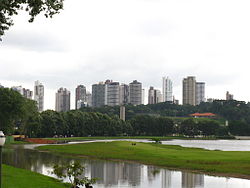 Curitiba from Barigüi Park | |
| Nickname: A cidade sorriso ("The smiling city") | |
| Motto: 'A Cidade da Gente' (Our City) | |
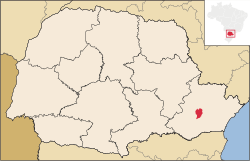 Location in the State of Paraná | |
 | |
| Country | |
| Region | South |
| State | |
| Founded | March 29, 1693 |
| Incorporated | 1842 |
| Government | |
| • Mayor | Carlos Alberto Richa (PSDB) |
| Area | |
| • Municipality | 430.9 km2 (166.4 sq mi) |
| • Metro | 15,416.9 km2 (5,952.5 sq mi) |
| Elevation | 934.6 m (3,066.3 ft) |
| Population (2007) | |
| • Municipality | 1,797,408 (7th) |
| • Density | 4,159.4/km2 (10,748.5/sq mi) |
| • Metro | 3,261,168 |
| • Metro density | 210.9/km2 (546.2/sq mi) |
| Time zone | UTC-3 (UTC-3) |
| • Summer (DST) | UTC-2 (UTC-2) |
| CEP | 80000-000 to 82999-999 |
| Area code | 41 |
| HDI (2000) | 0.856 – high |
| Website | Curitiba, Paraná |
Curitiba (pron. IPA: [kuɾi'tibɐ] or IPA: [kuɾi'tʃibɐ]) is the capital city of the Brazilian state of Paraná. The city has the largest population and also the largest economy in Southern Brazil. The population of Curitiba numbers approximately 1.8 million people (7th largest nationwide) and the latest GDP figures for the city surpass US$17 billion (ranking 4th nationwide) according to IBGE.[1]
Its metropolitan area comprises 26 municipalities[2] with a total population of over 3.5 million (IBGE estimate in 2006).[3] Curitiba is an important cultural, political and economic center in the country. The city is sits on a plateau at 932 metres (3,058 ft) above sea level. It is located 105 kilometres (65 mi) west of the sea port of Paranaguá and hosts the Afonso Pena International Airport.
Growth was based on the cattle trade, being half way between cattle breeding country to the South and markets to the North. Waves of European immigrants started arriving after 1850, mainly Germans, Italians, Poles and Ukrainians contributing to the economic and cultural development of the city. [citation needed]
Currently, the immigration of foreigners is small, is common only immigrants Middle Eastern[4] and South American countries, has been replaced by migration of Brazilians from other States of the country (it is estimated that nowadays about half the population of Curitiba is composed of migrants).[5]
Curitiba hosts the Universidade Federal do Paraná (Federal University of Paraná), the first in Brazil, was established in Curitiba in 1913, the same year in which electric streetcars were first deployed.
Name
One theory about the name "Curitiba" comes from the Tupi words kurí tyba, "many pine" due to the large number of Brazilian Pines (Araucaria angustifolia), in the region prior to its foundation.[6] The Portuguese who founded a village in 1693 gave it the name of "Vila da Nossa Senhora da Luz dos Pinhais" (Our Lady of the Light in the Pine Forest). The name was changed to "Curitiba" in 1721. Curitiba officially became a town in 1812, spelling its name as Curityba. An alternative spelling also came up: Coritiba. This spelling looked to become dominant for it was used in press and state documents, but a state decree in 1919 settled the dispute by spelling the city name Curitiba.[6]
History
This section needs expansion. You can help by adding to it. |
Geography
Climate
| Curitiba | ||||||||||||||||||||||||||||||||||||||||||||||||||||||||||||
|---|---|---|---|---|---|---|---|---|---|---|---|---|---|---|---|---|---|---|---|---|---|---|---|---|---|---|---|---|---|---|---|---|---|---|---|---|---|---|---|---|---|---|---|---|---|---|---|---|---|---|---|---|---|---|---|---|---|---|---|---|
| Climate chart (explanation) | ||||||||||||||||||||||||||||||||||||||||||||||||||||||||||||
| ||||||||||||||||||||||||||||||||||||||||||||||||||||||||||||
| ||||||||||||||||||||||||||||||||||||||||||||||||||||||||||||
Located in Southern Brazil, Curitiba is a somewhat humid city in a Subtropical zone. It is located in a plateau and the flat terrain with flooded areas contribute to its mild and damp winter, with average temperatures of 13 °C (55 °F) in the coldest month, falling slightly below 0 °C (32 °F), on the coldest days. During summer, the average temperature is around 21 °C (70 °F), but gets above 32 °C (90 °F) on hot days. It received snowfall in 1928,1942 and 1975. The highest temperature ever recorded in the city was 35.6 °C (96.1 °F). The all-time record lowest temperature was −8 °C (18 °F), but there is an unofficial record of −10.4 °C (13.3 °F).
In fact, of Brazil's twenty-six state capitals, Curitiba is the coldest due to altitude, despite being 600 kilometres (370 mi) north of Porto Alegre, the southernmost state capital in Brazil, but located at sea level.
Heat waves during winter and cold waves during summer are not uncommon, and even within a single day there can be great variation, a typical feature of subtropical climates. Several factors contribute to the climate's variable nature: The flat terrain surrounded by mountains in a rough circle with radius 40 kilometres (25 mi) help block the winds, allowing the morning mist to cover the city on cold mornings; The flatness of the terrain hinders quick water drainage after rains, therefore providing a good source of water vapor for the atmosphere; Cold fronts come often from Antarctica and Argentina all year round, bringing tropical storms in summer and cold winds in winter. They can move very quickly, with no more than one day between the start of the southern winds and the start of rain; Curitiba's weather is also influenced by the dry air masses that dominate Brazil's midwest most of the year, bringing hot and dry weather, sometimes even in winter.
Vegetation

Curitiba is located in the area of vegetation called Araucaria moist forests, composed of steppes, Araucaria forest and other formations. In the local vegetation still appear remnants of the parana pine (Araucaria angustifolia), which resisted the action of modern civilization. The parana pines are in private and public areas, now protected by environmental legislation which prevents it from being overturned. The Municipal Secretariat of the Environment maintains a botanical garden and three green houses for the annual production of 150,000 seedlings of native and exotic tree species, 16,000 seedlings of fruit trees, 260,000 seedlings of flowers, foliage and underbrush, on top of the total maintenance of 350,000 seedlings.[7] The green area of the city is one of largest in Brazil. The vegetation of Curitiba is also characterized by the existence of a large quantity of purple and yellow ipês (tabebuias), making a spectacle of beauty to the landscape of the city during the flowering in the end of winter. Currently, the yellow ipê is the most common tree in the city.[8]
Hydrography and Pluviometry
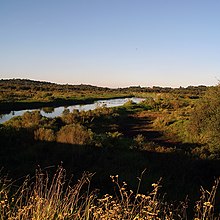
The catchment area of Curitiba consists of several rivers and streams that cross the city in different directions, grouped in six river basins. The main rivers that form the watershed of the city are: Atuba River, Belém River, Barigüi River, Passaúna River, Ribeirão dos Padilhas and the Iguaçu River, all with characteristics of dendritic drainage. Since the 1970s, Curitiba has working on alternatives to minimize the negative impacts of urbanization on rivers. An example of this was the construction of parks along the rivers with artificial lakes, which retain the water for longer periods of time, minimizing floods.[7] Currently, after many studies about the local water passages, almost all the rivers are in canalization process. Other alternatives developed to minimize the effects of urbanization are the implementation of the programs for environmental education, inspection and monitoring, elaboration and application of legislation and infrastructure works.[7] The index reaches 1,500 mm rainfall on average per year, because the rains are constant in the climate of the city. It happens, among other reasons, because of the large deforestation of the Mountain Range of the Sea (Serra do Mar), natural barrier to moisture.
Relief

The city has surface of 432.17 km² in the First Plateau of Paraná. The relief of Curitiba is just a little wavy. The average altitude of the city is 934.6 m or 3064 ft above sea level, ranging between minimum and maximum values of 900 and 1,000 meters, approximately.
Curitiba has a wavy topography of smooth rounded hills, an terrain a little wavy, giving a relatively regular physiognomy. The municipality of Curitiba has an average altitude of (934.6 m or 3064 ft) above sea level, where the highest point is to the north (1021 m or 3349 ft). To the south is the situation of lower altitude (864,9 m or 2864 ft). There are mountain ranges and sets of rocky elevations in practically all around the city, being the most remarkable and impressive of the Serra do Mar (portuguese for "Mountain Range of the Sea"), located in the east that separates the plateau from the coast of Paraná.
Urban planning




Curitiba has a master planned transportation system, which includes lanes on major streets devoted to a bus rapid transit system. The buses are long, split into three sections (bi-articulated), and stop at designated elevated tubes, complete with disabled access. There is only one price no matter how far you travel and you pay at the bus stop.[9]
The system, used by 85% of Curitiba's population, is the source of inspiration for the TransMilenio in Bogotá, Colombia; Metrovia in Guayaquil, Ecuador; as well as the Orange Line of Los Angeles, U.S. State of California, and for a future transportation system in Panama City, Panama.
The city has also paid careful attention to preserving and caring for its green areas, boasting 54 square metres (580 sq ft) of green space per inhabitant.[10]
In the 1940s and 1950s, Alfred Agache, cofounder of the French Society for Urban Studies, was hired to produce the first city plan. It emphasised a star of boulevards, with public amenities downtown, an industrial district and sanitation. It was followed when possible, but was too expensive to complete.[11]
By the 1960s, Curitiba's population had ballooned to 430,000, and some residents feared that the growth in population threatened to drastically change the character of the city. In 1964, Mayor Ivo Arzua solicited proposals for urban design. Architect Jaime Lerner, who later became mayor, led a team from the Universidade Federal do Paraná that suggested strict controls on urban sprawl, a reduction of traffic in the downtown area, preservation of Curitiba's Historic Sector, and a convenient and affordable public transit system.[12]
This plan, known as the Curitiba Master Plan, was adopted in 1968. Lerner closed XV de Novembro St. to vehicles, because it had very high pedestrian traffic. The plan had a new road design to minimise traffic: the Trinary Road System. This uses two one-way streets moving in opposite directions which surround a smaller, two-lane street where the express buses have their exclusive lane. Five of these roads form a star that converges to the city centre. Land farther from these roads is zoned for lower density developments, to reduce traffic away from the main roads. A number of areas subject to floods were condemned and became parks.[13]
Today, Curitiba is considered one of the best examples of urban planning worldwide.[14] In June 1996, the chairman of the Habitat II summit of mayors and urban planners in Istanbul praised Curitiba as "the most innovative city in the country."[15]
In the 1980s, the RIT (Rede Integrada de Transporte, Integrated Transport Network) was created, allowing transit between any points in the city by paying just one fare.[16] At the same time, the city began a project called the "Faróis de Saber" (Lighthouses of Knowledge). These Lighthouses are free educational centers which include libraries, Internet access, and other cultural resources. Job training, social welfare and educational programs are coordinated, and often supply labor to improve the city's amenities or services, as well as education and income.[17]
Curitiba is referred to as the ecological capital of Brazil, with a network of 28 parks and wooded areas. In 1970, there was less than 1 square meter of green space per person; now there are 52 square meters for each person. Residents planted 1.5 million trees along city streets. Builders get tax breaks if their projects include green space. Flood waters diverted into new lakes in parks solved the problem of dangerous flooding, while also protecting valley floors and riverbanks, acting as a barrier to illegal occupation, and providing aesthetic and recreational value to the thousands of people who use city parks.
The "green exchange" employment program focuses on social inclusion, benefiting both those in need and the environment. Low-income families living in shantytowns unreachable by truck bring their trash bags to neighborhood centers, where they exchange them for bus tickets and food. This means less city litter and less disease, less garbage dumped in sensitive areas such as rivers and a better life for the undernourished poor. There's also a program for children where they can exchange recyclable garbage for school supplies, chocolate, toys and tickets for shows. Under the "garbage that's not garbage" program, 70% of the city's trash is recycled by its residents. Once a week, a truck collects paper, cardboard, metal, plastic and glass that has been sorted in the city's homes. The city's paper recycling alone saves the equivalent of 1,200 trees a day. As well as the environmental benefits, money raised from selling materials goes into social programs, and the city employs the homeless and recovering alcoholics in its garbage separation plant.[18]
Government

The executive is currently exercised by the mayor Beto Richa (elected in 2004 and with a mandate until 2008), by the deputy mayor (vice mayor) Luciano Ducci and the municipal secretaries appointed by the mayor. The City Council of Curitiba was created in 1693, and has a total of 38 councillors elected since 2004.
Curitiba is divided into nine regional governments (equivalent to subprefecture), who manage the 75 districts of the municipality. The Rua da Cidadania ("Street of Citizenship") is the symbol of administrative decentralization; it is a reference point and meeting place for the user of municipal utilities, in a regional context, taking into account the needs and rights of the citizen in trade, leisure and services, facilitating the access of the population for different services in the areas of health, justice, policing, education, sport, housing, environment, urban planning, social service and supply, etc. Several units work annexed to the terminals of public transport in Curitiba. Their nuclei offer services in the local, state and federal areas.
Demographics


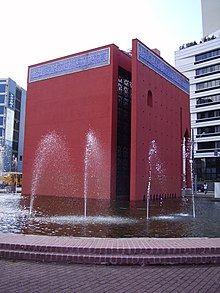
According to the IBGE of 2007, there were 3,230,000 people residing in the Metropolitan Region of Curitiba. The population density was 4,159.4 inhabitants per square kilometre (10,773/sq mi). The last PNAD (National Research for Sample of Domiciles) census revealed the following numbers: 2,503,250 White people (77.4%), 584,000 Pardo (Brown) people (18.2%), 93,000 Black people (2.9%), 45,000 Asian or Amerindian people (1.4%).[19]
As most of Southern Brazil's population, Curitiba is mostly inhabited by Brazilians of European descent. The first Europeans to arrive in the region were of Portuguese origin, during the 17th century. They intermarried with the native people and with the African slaves.[20]
In the 19th century, the influx of immigrants from Europe increased. In 1828, the first German immigrants settled in Paraná. However, large numbers of immigrants from Germany only arrived in Curitiba during the 1870s, most of them coming from Santa Catarina or Volga Germans from Russia.[21]
Immigrants from Poland first arrived in 1871, settling in rural areas close to Curitiba. They largely influenced the agriculture of the region. Curitiba has the second largest Polish diaspora in the world, second only to Chicago.[20] The Memorial of Polish Immigration that was inaugurated in 13th December 1980, after the visit of the Pope John Paul II to the city of Curitiba, in June, in the same year. Its area is 46 thousand square meters was part of the dispossession of the old Candles plant. The seven trunks wood houses are parts of this memorial area, as Polish Immigrants souvenir and their faith and fight. Objects like the old wagon, the pipe of cabbage and the black virgin of Czestochowa print, who is the protector saint of Polish people are parts of its quantity.[22]
Italian immigrants started arriving in Brazil in 1875 and in Curitiba in 1878. They came mostly from the Veneto and Trento regions, in Northern Italy and settled mostly in the Santa Felicidade neighborhood, still today the center of the large Italian community of Curitiba.[23]
Large numbers of Ukrainian immigrants settled in Curitiba, mostly between 1895 and 1897, when 20 thousands arrived. They were peasants from Galicia, who immigrated to Brazil to become small farmers. Nowadays there are 300 thousand Ukrainian-Brazilians living in Paraná.[24][25] The State of Paraná has the largest Ukrainian community of the country.
Curitiba has a well established Jewish community[26] originally established in the 1870s.[27] Much of the early Jewish congregation has been assimilated.[28] In 1937 with the rise of Nazi power, several notable German Jewish Academics were allowed into Brazil, some of them settling in Curitiba.[29]
Physicist César Lattes and former mayors Jaime Lerner,[30] Saul Raiz and Nei Braga were Jewish. A monument in memory of the Holocaust has been erected in the city. There is also a Habad house in Curitiba "Beit Chabad" as well as at least two synagogues[31] and two Jewish cemeteries,[32] one of which was defiled by antisemites in 2004.[33]
Japanese immigrants began arriving in the region in 1915. Most Japanese settled in the State of São Paulo, but many settled in Northern Paraná, cities such as Maringá and Londrina. Curitiba also received significant numbers of immigrants from Japan. Nowadays, there are about 40 thousand Japanese-Brazilians living in the city.[34]
Other immigrants, such as Lebanese, Syrians, Palestinians, Russians and other Eastern Europeans also settled in Curitiba.
Economy

According to IPEA data, the GDP is estimated at real 29 billion, without recording activities in the agriculture and livestock farming (0.03%) sectors. Industry represented 34.13% and the commerce and service sectors 65.84%. [citation needed]
Cidade Industrial de Curitiba, the industrial district of Curitiba, is home to many multinational industries, such as Nissan, Renault, Volkswagen, Audi, HSBC, Siemens, ExxonMobil, and Kraft Foods, as well as many national industries, such as Sadia, O Boticário, Positivo Informática.
Curitiba's infrastructure makes bus travel fast and convenient, effectively creating demand for bus use in the same way that the infrastructure of traditional cities creates demand for private motor vehicles.
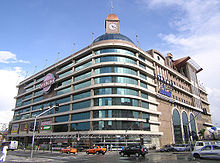
In July 2001, Curitiba has become the first city in the country to receive the prize "Pole of Information Technology", granted by InfoExame magazine, because the performance of their companies of technology. According to the magazine, the number of companies of "Technology and Information Technology" based in Curitiba submitted in 2001 a turnover of US$1.2 billion, representing a growth of 21% over the previous year.[35]
The GDP for the city is R$ 29,821,203,000 (2005).[36]
The per capita income for the city was R$ 16,964 (2005).[37]
Education

Portuguese is the official national language, and thus the primary language taught in schools. But English and Spanish are part of the official high school curriculum.
Educational institutions include
- Universidade Federal do Paraná (UFPR);
- Universidade Tecnológica Federal do Paraná (UTFPR);
- Pontifícia Universidade Católica do Paraná (PUCPR);
- Universidade Tuiuti do Paraná (UTP);
- Universidade Positivo (UP);
- Centro Universitário Franciscano do Paraná (UNIFAE);
- Faculdade de Tecnologia (FATEC);
- Faculdade Curitiba;
- and many others.
Culture

Arts and entertainment
Curitiba is the first city in Brazil to have an IMAX cinema. It is in the Palladium Shopping Center[38] which is the biggest mall in Southern Brazil.
Curitiba also has many Theaters. The biggest and most important one is the "Guaíra Theater".[39]
Every year, in April, it hosts the "Curitiba Theater Festival",[40] with various artists playing in Curitiba Theaters and even on the squares.
Museum

- Museu Paranaense ("Paranaense Museum") - dedicated to the arts and history;
- Oscar Niemeyer Museum - the largest museum of Latin America,[41] dedicated to plastic arts;
Tourism and recreation







24 Horas Street
The Street that never sleeps is the synthesis of a city which also never sleeps. It is 120 meters long and 12 meters wide. It is composed by 32 arches in metallic tubular structure, trademark of the modern curitibana architecture.
Botanic Gardens
Curitiba’s trademark, created to resemble French gardens, rolls out its flower carpet to the visitors right at the entrance. The greenhouse, with a metallic structure, has botanic species that are national reference, and also a water fountain.
The native forest is filled with paths for walking. The Botanic Museum attracts researchers from all over the world. There is a space for exhibitions, library and a theatre.
German Woods
The wood has various features to celebrate and promote the German traditions. There are 38 thousand square meters of native forest, which was part of the old farm from the Schaffer family. The replica of an old wooden church, built in 1933 at the Seminário neighbourhood, with neo-gothich decorative elements, shelters a concert hall called Bach’s Oratorium.
Other attractions are the John and Mary path, which tells the Grimm brothers tale, a children’s library, the Philosophers Tower, a wooden observatory allowing a panoramic view of the city and the Ocean Ridge, and the German Poetry Square, with a reproduction of the Casa Mila façade, a German building from the beginning of the last century, originally located in the city centre. It's closed for remodeling at the present time.
Italian Woods
A place for the typical parties of the Italian community in the district, such as the Grape Party, the Wine Party and the 4 Giorni in Italy. It has structure for food and drinkstalls, space for shows and folkloric presentations and a polenta pot.
Japan Square
Homage to Japanese immigrants who settled there dedicating themselves to agriculture. Scattered around the square are 30 cherry trees sent from Japan and artificial lakes. In 1993 the Japanese Portal, the Culture House and the Tea House were built.
Tingüi Park
Part of the biggest linear environmental park in the Country, established at the Barigüi river margins, it reminds us of the Indians who used to live there, with the statue of Tindiqüera Chieftain. The Ukrainian Memorial is also there, homage to the immigrants, in a replica of an orthodox church, originally built in inland Paraná State, hosting a pêssankas and icons exhibition.
Wire Opera House
It is one of the emblematic symbols of Curitiba, with tubular structure and transparent ceiling, of great beauty. Inaugurated in 1992, it caters for all types of shows, between lakes, typical vegetation and cascades, on a unique landscape. The Wire Opera House is part of the Pedreiras Park, together with the Paulo Leminski Cultural Space, where the Passion of Christ was enacted, and hosted many other big events since 1989, and can receive, in open air, 10 thousand people seating or 50 thousand standing.
Tanguá Park
This park was inaugurated in 1996, the Tanguá Park surprises with its beauty as an example of urban space being re-utilized - on one old complex of disactivated quarries -, and it is part of the Barigüi river preservation project joining Tingüi and Barigüi parks. This park with an area of 450 thousand square meters has two quarries connected by a 45 meter tunnel that may be crossed on foot by a path over the water. It can be visited on boat or on foot (hiking). The park has a cooper and bicycle track, snack bar, belvedere and Poty Lazzaroto garden.
Portugal Wood
Homage to the Portuguese-Brazilian bonds, this space is highlighted by a track following a small brook, where one can see drawn on tiles excerpts from famous Portuguese language poets, as well as a tribute to the great Portuguese navigators and their discoveries.
Curitiba Iternational Ecological Marathon
In November, happens the Maratona Ecológica Internacional de Curitiba ("Curitiba International Ecological Marathon"). This marathon is known as the hardest in Brazil,[42] because happens in the end of the year, when usually is warm weather in the city (because is summer in Southern Hemisphere), and the hilly course, with many of the inclines being in the last 10km. To compensate the hard course, runners count with good structure[43] and enthusiastic fans cheering along the course.[44]
Tourism Line
Every year, tourism grows in Curitiba. To attend this demand, the Linha Turismo ("Tourism Line") started in 1994. Its a special city tour that visits the principal tourist attractions in Curitiba, featuring comfortable white buses with big windows and a shape similar to that of streetcars. The vehicles are equipped with a sound system that plays recorded messages describing sites in three different languages: Portuguese, English and Spanish. It is possible to visit the parks, squares and the rest of the city's tourist attractions. Considered one of the best in the country, the Linha Turismo is available every thirty minutes and has a two and a half-hour tour, which travels around forty-four kilometers. To go on the tour you must buy a ticket with five tickets that give you the right to get on and off bus four times. Users can therefore choose the touristic point where they want to stay longer. Then, they can embark again to complete the remaining part of the itinerary. Today the line goes to 25 key reference points in Curitiba, completing 44 km in 2 and ½ hours.
UN Convention on Biodiversity

From March 20th to the 31st an important world gathering of the United Nations on biodiversity is taking place in Curitiba, addressing items of the 1993 Convention on Biological Diversity adopted by 188 countries. This gathering is the most important of all those organized by the United Nations, because, in fact, it seeks to discuss strategies to safeguard life from the threats directed against it. Starting with the Summit of the Earth or Rio de Janeiro Eco-92 the topic has been gaining centrality and has been the subject of numerous official documents, especially the 2000 and 2003 Cartagena Protocols on biosecurity. The Curitiba preparatory document, developed by specialists of the UN and of the Brazilian Ministry of the Environment for issues from Brazil, defines biodiversity as follows: including all the different species of plants, animals and microorganisms (estimated in more than 10 million species), all the genetic variability within the species (10 to 100 genes per specie) and all the diverse ecosystems formed by different combinations of species. Biodiversity includes the environmental services responsible for maintenance of life on Earth, for the interaction between living beings and for the offer of goods and services that sustain human societies and their economies.[45]
Transport
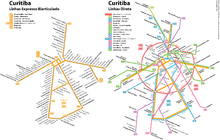
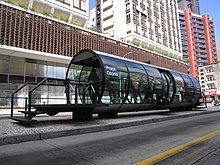


Public Transport
Curitiba has a unique transportation system, developed locally and causing much interest worldwide.[46] This Bus Rapid Transit system, is very simple and practical. Public transportation consists entirely of buses. There are several different types of bus, each with a different function. All stations are easily accessed, are enclosed, and the busses have been changed to make for easier entry and exit.[47] Together with other low-cost changes, this bus system aims at becoming a comfortable and preferred transportation choice for the public.[48]
The popularity of Curitiba's BRT has effected a modal shift from automobile travel to bus travel. Based on 1991 traveler survey results, it was estimated that the introduction of the BRT had caused a reduction of about 27 million auto trips per year, saving about 27 million liters of fuel annually. In particular, 28 percent of BRT riders previously traveled by car. Compared to eight other Brazilian cities of its size, Curitiba uses about 30 percent less fuel per capita, resulting in one of the lowest rates of ambient air pollution in the country. Today about 1,100 buses make 12,500 trips every day, serving more than 1.3 million passengers, 50 times the number from 20 years ago. Eighty percent of travelers use the express or direct bus services. Best of all, Curitibanos spend only about 10 percent of their income on travel, much below the national average.[49]
Curitiba's Master Plan integrated transportation with land use planning, calling for a cultural, social, and economic transformation of the city. It limited central area growth, while encouraging commercial growth along the transport arteries radiating out from the city center. The city center was partly closed to vehicular traffic, and pedestrian streets were created. Linear development along the arteries reduced the traditional importance of the downtown area as the primary focus of day-to-day transport activity, thereby minimizing congestion and the typical morning and afternoon flows of traffic. Instead, rush hour in Curitiba has heavy commuter movements in both directions along the public transportation arteries.
Other policies have also contributed to the success of the transit system. Land within two blocks of the transit arteries is zoned for high density, since it generates more transit ridership per square foot. Beyond the two blocks, zoned residential densities taper in proportion to distance from transitways. Planners discourage auto-oriented centers and channel new retail growth to transit corridors. Very limited public parking is available in the downtown area, and most employers offer transportation subsidies, especially to low-skilled and low-paid employees.
Roads

Moving around in a car can be difficult in and around the city centre because of the many one-way streets and frequent traffic jams. This makes the public transportation system more attractive if one wants to go there. The trinary system allows quick access to the city centre for car drivers. Some avenues are spacious and laid out in a grid, and apart from some points around the city centre, Munhoz da Rocha Street and Batel Avenue, traffic jams are not thus severe.[50] Recently, the city installed around 140 traffic radars, causing much discontent among drivers in general.[51]
International Airport
Afonso Pena International Airport is Curitiba's main airport. It is located in the nearby city of São José dos Pinhais and all commercial flights operate from this airport. With a constructed area of 45 thousand square meters, Afonso Pena/Curitiba International Airport serves some 3.5 million passengers a year. The apron has 19 boxes for aircraft parking, six of them served by boarding bridges from the terminal. The airport also has auxiliary buildings, a waste treatment station, a large parking lot, and is encircled by expansive grassy areas and gardens.[52] (Small aircraft may also use the Bacacheri airport.) It is integrated into Curitiba's transportation system, with rapid buses and shuttle service connecting the airport to the city.
Sports


Curitiba provides visitors and residents with various sport activities. There are several soccer clubs based in Curitiba. The most important ones - Brazilian mid-class clubs - are:
- Campeonato Brasileiro Série A champion in 1985.
- Campeonato Brasileiro Série A champion in 2001.
- Campeonato Brasileiro Série B champion in 1992 and 2000.
Stadiums:
- Coritiba Foot Ball Club: Estádio Major Antônio Couto Pereira, Capacity: 37,182
- Clube Atlético Paranaense: Estádio Joaquim Américo Guimarães, Capacity: 25,272
- Paraná Clube: Estádio Durival Britto e Silva, Capacity: 24,303.
Curitiba is one of the 18 remaining candidates to host games of the 2014 FIFA World Cup to be held in Brazil.[53]
Neighborhoods


Bairros (neighbourhoods) of Curitiba are geographical divisions of the city. There is no delegation of administrative powers to neighborhoods, although there are several neighborhoods associations devoted to improve their own standards of living. Curitiba is divided into 9 regional governments (boroughs) covering the 75 neighbourhoods of the city. All districts are served by the system of integrated urban transport.
Most districts of Curitiba was born of colonial groups formed by families of European immigrants in the second half of the nineteenth century.
The centre ("Downtown" in American English or "CBD" - central business district - in other English use), place of foundation of the city, is the most bustling area, which concentrates most of the financial institutions of Curitiba.
List of neighborhoods by regional:
- Matriz: Centro, Centro Cívico, Batel, Bigorrilho, Mercês, São Francisco, Bom Retiro, Ahu, Juvevê, Cabral, Hugo Lange, Jardim Social, Alto da XV, Alto da Glória, Cristo Rei, Jardim Botânico, Prado Velho and Rebouças;
- Santa Felicidade: Santa Felicidade, Lamenha Pequena, Butiatuvinha, São João, Vista Alegre, Cascatinha, São Brás, Santo Inácio, Orleans, Mossunguê, Campina do Siqueira, Seminário, CIC (north region) and part of Campo Comprido;
- Boa Vista: Boa Vista, Bacacheri, Bairro Alto, Tarumã, Tingüi, Atuba, Santa Cândida, Cachoeira, Barreirinha, Abranches, Taboão, Pilarzinho and São Lourenço;
- Cajuru: Cajuru, Uberaba, Jardim das Américas, Guabirotuba and Capão da Imbuia;
- Fazendinha/Portão: Portão, Fazendinha, Santa Quitéria, Vila Isabel, Água Verde, Parolin, Guaíra, Lindóia, Fanny, Novo Mundo and part of Campo Comprido;
- Boqueirão: Boqueirão, Xaxim, Hauer and Alto Boqueirão;
- Pinheirinho: Pinheirinho, Capão Raso, Tatuquara, Campo de Santana and Caximba;
- Bairro Novo: Sítio Cercado, Ganchinho and Umbará;
- Cidade Industrial de Curitiba: CIC (center and south region), Riviera, Augusta and São Miguel.
Sister cities
The Sister Cities of Curitiba are:
Famous places

Curitiba is mostly known for some of its famous places:
- Autódromo Internacional de Curitiba
- Bosque Alemão
- Bosque de Portugal
- Feirinha do largo da ordem
- Jardim Botânico de Curitiba
- Ópera de Arame
- Rua XV de Novembro
- Universidade Federal do Paraná
Notable people





Arts
- Isabeli Fontana - Super Model
- Paulo Leminski - Poet and Writer
- Jaime Lerner - Architect and Urbanist
- Larry Grehan - Irish writer
- Guilherme Weber - Actor
- Isadora Ribeiro - Actress
- Marjorie Estiano - Actress
- Vilanova Artigas - Architect
Aviation
- Pierre Clostermann - WWII fighter french pilot, engineer
Science
- César Lattes - Physicist
- Newton da Costa - Mathematician
- Ned Kock - Systems Scientist
Politics
- Beto Richa (Mayor of Curitiba)
- Roberto Requião (Governor of the State of Paraná)
Sports
- Ricardo Zonta - Formula One driver. 1998 FIA GT Championship champion
- Enrique Bernoldi - Formula One driver
- Rolando Ferreira - (Gold medalist at the 1987 Pan American Games)
- Emanuel Rego (Gold medalist in 2004 Olympics)
References
- ^ IBGE, Produto Interno Bruto dos Municípios 2005. Retrieved in 07/April/2008.
- ^ Mapa da Região Metropolitana de Curitiba - Paraná
- ^ "Região Metropolitana" (in Portuguese). Prefeitura Municipal de Curitiba. Retrieved 2007-01-08.
- ^ "A imigração árabe muçulmana em Curitiba" (in Portuguese). Etni-cidade. Retrieved 2008-10-03.
- ^ "Quase metade de Curitiba é dos "estrangeiros"" (in Portuguese). Bem Paraná. Retrieved 2008-08-06.
- ^ a b Fenianos, E. (2003) Almanaque Kur'yt'yba, Curitiba: Univer Cidade, p.6
- ^ a b c "City of Curitiba, Brazil". Convention on Biological Diversity. Retrieved 2008-05-23.
- ^ "Livro mostra roteiros das árvores de Curitiba/Pr" (in Portuguese). Ambiente Brasil. Retrieved 2005-05-25.
- ^ Jonas Rabinovitch and Josef Leitman, "Urban Planning in Curitiba", Scientific American, vol. 274, no. 3 (March 1996), pp. 46-53
- ^ Curitiba busca recuperação de biodiversidade local Terra - Ambiente
- ^ Prefeitura ENG
- ^ www.mcachicago.org/massivechange/timelines/urban.pdf
- ^ Parks of Curitiba and floods
- ^ Irazábal, Clara Elena (2002) Curitiba and Portland: Architecture, City Making, and Urban Governance in the Era of Globalization, Ph.D. Dissertation in Architecture, University of California, Berkeley, p.112
- ^ Curitiba - urban plannig
- ^ RIT Curitiba - Trajetory
- ^ Social programs in the city
- ^ Curitiba a green city
- ^ Síntese de Indicadores Sociais 2007 (PDF) (in Portuguese). Curitiba, Brazil: IBGE. 2007. ISBN 85-240-3919-1. Retrieved 2007-07-18.
- ^ a b http://www.curitiba.pr.gov.br/pmc/curitiba/index.asp?noframe=sim&conteudo=imigra/index.html
- ^ http://www.expoente.com.br/professores/kalinke/trabalhos/Hp-Alemaes/historia/Hist%C3%B3ria%20da%20imigra%C3%A7%C3%A3o%20Alem%C3%A3.html
- ^ Polish Memorial of Curitiba
- ^ Imigrantes Italianos em Curitiba
- ^ Memorial Ucraniano - Curitiba
- ^ :Governo do Estado do Paraná:
- ^ Jews of Brazil site Source listing Curitiba as one of the important Jewish communities. A Habad article gives the number of 844 religious participating families there in the year 2007
- ^ Brazil's Jews during the Vargas Era and After by Robert M. Levine 1968. This is a book about early Jewish settlers in Brazil
- ^ Digital edition of Levine's book
- ^ A research paper about the Jewish immigration to Brazil during the second world war.
- ^ Heschel Center in Israel: Mayor Jaime (Chaim) Lerner a proud Jew
- ^ Israel Synagogue in addition to the Hevra Kadisha Synagogue and the Habad Synagogue mentioned in the Chabad reference
- ^ Jewish Geneaology site lists cemeteries.
- ^ Stephen Roth Institute: Antisemitism And Racism
- ^ Praça do Japão - Curitiba
- ^ "A capital do Paraná se destaca na área de TI e oferece oportunidades para profissionais do setor" (in Portuguese). Revista TI. Retrieved 2003-10-11.
- ^ GDP (PDF) (in Portuguese). Curitiba, Brazil: IBGE. 2005. ISBN 85-240-3919-1. Retrieved 2007-07-18.
- ^ per capita income (PDF) (in Portuguese). Curitiba, Brazil: IBGE. 2005. ISBN 85-240-3919-1. Retrieved 2007-07-18.
- ^ Palladium Shopping Center
- ^ Teatro Guaíra
- ^ Festival de Teatro de Curitiba
- ^ "Museu Oscar Niemeyer" (in Portuguese). Descubra Curitiba. Retrieved 2008-01-17.
- ^ "Maratona Ecológica de Curitiba - Ladeiras e incentivos do povo curitibano" (in Portuguese). Copacabana Runners. Retrieved 2008-08-07.
- ^ "RUN THE CURITIBA MARATHON" (PDF). Charity Giving. Retrieved 2008-08-07.
- ^ "MARATONA ECOLÓGICA INTERNACIONAL DE CURITIBA" (PDF) (in Portuguese). Faculdade de Desporto da Universidade do Porto. Retrieved 2008-08-07.
- ^ UN Convention on Biodiversity and Biosecurity
- ^ CNN Transcript - Special Event: The People's Planet - December 24, 2000
- ^ EPA-International Best Practices & Innovations-Urban Management, Sustainable Transport and Mobility Management
- ^ Curitiba Transportation Workshop
- ^ Urban transport of Curitiba
- ^ Roads in Curitiba
- ^ Traffic radars in Curitiba
- ^ Afonso Pena International Airport
- ^ Curitiba | FIFA World Cup 2014
- ^ a b c d e f g "Cidades-irmãs" (in Portuguese). Câmara Municipal de Curitiba. Retrieved 2007-05-22.
- ^ "Acordos de Geminação" (in Portuguese). Câmara Municipal de Coimbra. Retrieved 2008-02-17.
- ^ a b "Asuntos Federales y Electorales - Ciudades y Provincias argentinas hermanadas con contrapartes extranjeras" (in Spanish). Secretaría de Relaciones Exteriores. Retrieved 2008-07-02.
- ^ "Honorowe Miasta Bliźniacze - Kurytyba (Brazylia)" (in Polish). Krakow.pl. Retrieved 2006-01-13.
- ^ "Curitiba, une ville modèle du développement durable" (in French). Veille Technologique. Retrieved 2005-11-30.
- ^ "Online Directory: Florida, USA". Sister Cities International. Retrieved 2008-04-17.
- ^ "Cenni storici ed informazioni generali su Treviso" (in Italian). BelPaese.it. Retrieved 2008-04-28.

